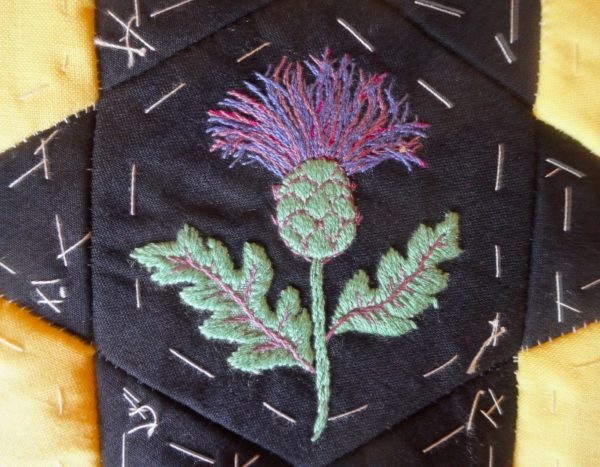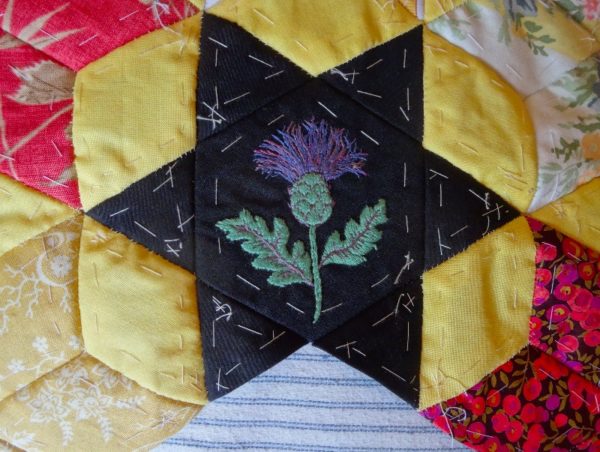
Ipsden altar frontal: the thistle (hand embroidered by Mary Addison)
I am addicted to my daily newspaper and feel that the day has never really begun until I’ve had a quick swish through its crackling sheets. Two of my favourite columns are titchy little things of modest pretensions, which I might well overlook were it not for their reliably occupying the same place in the paper every day. First I scan Lindsay Bareham’s daily recipe for a bit of inspiration for the evening meal (tucked helpfully on the reverse of the front page) and then I flick noisily and progressively impatiently through to the leader page where Derwent May’s little column of 3 scant inches (including black and white drawing) sits, half disappearing around the fold, just north of birthdays of the famous and east of the voice of the paper as delivered in it s 3 leader pieces. Entitled simply “Nature Notes”, it keeps me informed of what should or might be happening in and beyond the garden and these little pieces have become even more important now I look onto walls of brick and glass rather than fields of ever changing colour. Though I take Derwent May’s prose soberly I find myself unable to suppress thoughts of that other nature writer (William Boot in Evelyn Waugh’s “Scoop”) who, confused with a war correspondent of similar name, finds the “Lush Places” of his usual column replaced by the not so pleasant setting of war torn Ishmaelia, where – through no fault of his own – he gets the scoop of the title. ( For an example of his bucolic style try “feather-footed through the plashy fen passes the questing vole”).

Ipsden altar frontal: the thistle (hand embroidered by Mary Addison)
Well, Derwent May (in his 80s and still going strong – I hope) is not so given to the overblown prose of William Boot but has a lyrical turn of phrase and is often there when you want a bit of enlightenment. In Thursday’s Nature Notes he turned his thoughts to the thistle, Acknowledging the plant’s summer unpopularity for aggressive colonisation and vicious prickles, he reminds us the appearance of the first leaves are as good a harbinger of spring as anything. “Field thistles, which are our most abundant thistle, are now appearing as glittering silvery-white stars flush with the ground on damp paths. Near by there may also be the first leaves of wild strawberry, each with three green or even red leaflets. On hedge banks, goosegrass – another plant that will rampage in summer, often invading flowerbeds – is coming up to begin with as little green pagodas. Also detectable in sheltered spots in woods are the dark green heart-shaped leaves of sweet violets.” There, doesn’t that make you want to rush out and check them all out? This year I shall miss the little wild violets in the churchyards – I don’t think I’ll find them in Islington.

8 Comments
I am still in a state of shock regarding TURNSTILES at St Pauls mentioned in your previous post. I realize they need money for upkeep but still …
Re the Ipsden altar frontal – are you planning to quilt it or just back it – somewhat like the Jane Austen coverlet?
Anne
Yes, I still find St Paul’s turnstiles problematic. When my husband and I visited York Minster a few years ago we queued for tickets with everyone else and regarded ourselves as rather lucky that it was accepted my husband was a church of England priest and we were allowed into the minster free. But if you just wanted to nip in for a bit of quiet meditation, I don’t think there’s any provision – unless you attend a service.
I am planning to quilt the altar frontal, although I’ve not yet decided exactly how.
I too have a problem with turnstiles…….
But do keep looking for violets in Islington, it is always amazing what can be found in unexpected corners. I will search too next time I trot along to Loop from the City.
‘Violets in Islington’ the title of a mid 20th Century novel after the style of Barbara Pym
Well, I too will keep on looking Jane. But, as all the local parks have been so scoured by leaf clearing or overwhelmed by composted material that even the grass is difficult to find, so I’m not overly optimistic!
Turnstiles?
On the other hand, if people are visiting a church building to admire the architecture/history/whatever – basically anything other than for purposes of worshipping Almighty God – they should contribute to the upkeep and repair of ‘wear and tear’ resulting from their visits.
Sometimes I’m glad I’m a Non-Conformist and we don’t have the situation!
I know – it’s a conundrum I appreciate with historic religious buildings and that’s why the humble village church has much to recommend it – the village churches under my husband’s care in Oxfordshire were open all day to visitors and walkers often stopped and had their lunch there.
I love your thistle! Much nicer than the ones I have to weed out of my own garden. I am glad you are enjoying a bit of nature in whatever guise you find it. The foxglove above is lovely too, but I am partial to this loose looking thistle.
Thank you Amara. The thistle was lovely to do with all those intermingled colours and I quite like its raggedyness too. It’s not at all easy to make embroidered flowers look so tactile – the foxglove is far too staid and confined by blocks of stitching but sometimes you just have to settle for how it works out at the time.